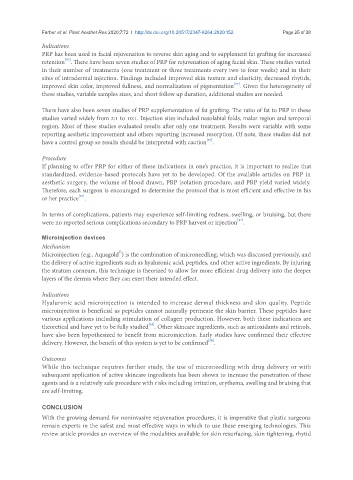Page 875 - Read Online
P. 875
Farber et al. Plast Aesthet Res 2020;7:72 I http://dx.doi.org/10.20517/2347-9264.2020.152 Page 25 of 28
Indications
PRP has been used in facial rejuvenation to reverse skin aging and to supplement fat grafting for increased
[57]
retention . There have been seven studies of PRP for rejuvenation of aging facial skin. These studies varied
in their number of treatments (one treatment or three treatments every two to four weeks) and in their
sites of intradermal injection. Findings included improved skin texture and elasticity, decreased rhytids,
[57]
improved skin color, improved fullness, and normalization of pigmentation . Given the heterogeneity of
these studies, variable samples sizes, and short follow up duration, additional studies are needed.
There have also been seven studies of PRP supplementation of fat grafting. The ratio of fat to PRP in these
studies varied widely from 2:1 to 10:1. Injection sites included nasolabial folds, malar region and temporal
region. Most of these studies evaluated results after only one treatment. Results were variable with some
reporting aesthetic improvement and others reporting increased resorption. Of note, these studies did not
[57]
have a control group so results should be interpreted with caution .
Procedure
If planning to offer PRP for either of these indications in one’s practice, it is important to realize that
standardized, evidence-based protocols have yet to be developed. Of the available articles on PRP in
aesthetic surgery, the volume of blood drawn, PRP isolation procedure, and PRP yield varied widely.
Therefore, each surgeon is encouraged to determine the protocol that is most efficient and effective in his
[57]
or her practice .
In terms of complications, patients may experience self-limiting redness, swelling, or bruising, but there
[57]
were no reported serious complications secondary to PRP harvest or injection .
Microinjection devices
Mechanism
Ò
Microinjection (e.g., Aquagold ) is the combination of microneedling, which was discussed previously, and
the delivery of active ingredients such as hyaluronic acid, peptides, and other active ingredients. By injuring
the stratum corneum, this technique is theorized to allow for more efficient drug delivery into the deeper
layers of the dermis where they can exert their intended effect.
Indications
Hyaluronic acid microinjection is intended to increase dermal thickness and skin quality. Peptide
microinjection is beneficial as peptides cannot naturally permeate the skin barrier. These peptides have
various applications including stimulation of collagen production. However, both these indications are
[38]
theoretical and have yet to be fully studied . Other skincare ingredients, such as antioxidants and retinols,
have also been hypothesized to benefit from microinjection. Early studies have confirmed their effective
[58]
delivery. However, the benefit of this system is yet to be confirmed .
Outcomes
While this technique requires further study, the use of microneedling with drug delivery or with
subsequent application of active skincare ingredients has been shown to increase the penetration of these
agents and is a relatively safe procedure with risks including irritation, erythema, swelling and bruising that
are self-limiting.
CONCLUSION
With the growing demand for noninvasive rejuvenation procedures, it is imperative that plastic surgeons
remain experts in the safest and most effective ways in which to use these emerging technologies. This
review article provides an overview of the modalities available for skin resurfacing, skin tightening, rhytid

